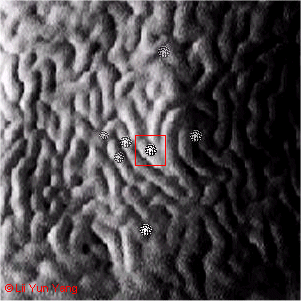More at 1 micrometerThere is an important relationship between the size of an object and the energy required to 'visualize' it. The smaller an object, the more energy that is required to resolve it. The wavelengths of visible light -- a tiny fraction of the electromagnetic spectrum -- are what our eyes use to see the objects of everyday life. Visible wavelengths are much smaller than the objects we need to recognize and provide us with sufficient detail at the human scale. However the wavelengths of visible light are too big to resolve any objects smaller than about a micrometer in size. In order to form an image of objects smaller than a micrometer, higher energy bands of the electromagnetic spectrum are needed. The relationship between energy, wavelength, and frequency is graphically presented on three logarithmic scales. (The Scales page can also be reached at any time from the index or the site map by clicking on the Scales button.) Genetics -- Ribonucleic Acid (RNA)A polypeptide is a building block of proteins and is composed of a string of amino acids. The process by which DNA specifies a polypeptide is intricate and fascinating. Within the nucleus, a section of DNA uncoils from its chromosome packing and the two strands of the double helix separate for a portion of their length. One side acts as a template for messenger RNA (mRNA). (RNA differs from DNA in that uracil (U) replaces thymine (T) as one of the four bases.) The strand of DNA 'AGCTGA' would produce a 'UCGACU' sequence of mRNA. The thread of mRNA moves out of the nucleus into the cytoplasm of the cell. There, one end of the thread becomes inserted into a ribosome which reads the sequence of bases on the mRNA. The reading, called translation, takes place by means of a third type of RNA called transfer RNA (tRNA). One side of the tRNA is a triplet of nucleotides (the anti-codon). On the other side is a region specific to one amino acid. The triplet on each tRNA is complementary to one particular sequence of three nucleotides on the mRNA strand (the codon). As a tRNA molecule (with its attached amino acid) moves up the strand of mRNA in the ribosome bead the codon and anti-codon attract and bind. As the ribosome travels along the thread of mRNA a string of amino acids are bound together forming a polypeptide chain. When released from the ribosome the polypeptide folds up into its characteristic shape as determined by the sequence of amino acids. |
